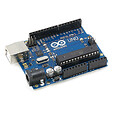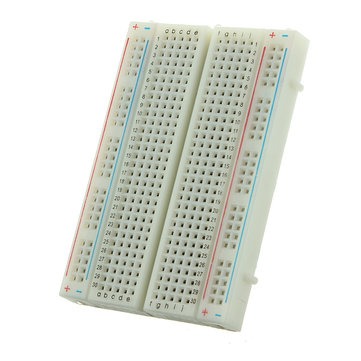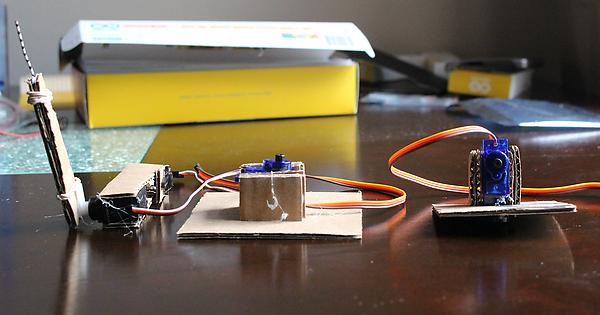COMPONENTS AND SUPPLIES
Arduino Uno R3 China Rotary Encoder with Push Switch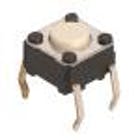 pSparkFun Pushbutton switch 12mm
pSparkFun Pushbutton switch 12mm
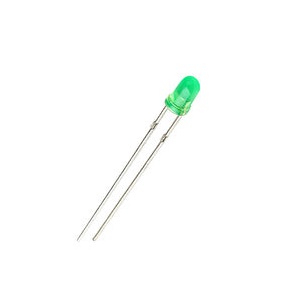 https://electra.store/product/led-green-green-3mm/
https://electra.store/product/led-green-green-3mm/
ABOUT THIS PROJECT
About
This is just a simple robot arm made out of readily available materials and instruments, such as micro servos, cardboard, and hot glue, designed for beginners. The code and circuit can be improved, so feel free to make changes and learn!
Features
It can record and play five positions using potentiometers and buttons. (But you can add as many as you want).
Demo
Arm Assembly
Pictures of the arm assembly can be found here:
Similar instructions can also be found at 0:18 in the Version 2 video below in the Update section
Everything should be able to run off of a power supply from a computer via the USB, but adding an external power supply is also possible, just make sure the servo can take it.
CODE
//Code written by Ryan Chan; it is pretty inefficient, but gets the job done, I challenge you to make it more efficient!
//*IMPORTANT CHANGES IN VERSION 2: LEDs 4 and 5 have been moved to pins 7 and 8 respectively; Buttons 1 and 2 have been moved to pins 12 and 13 respectively. This is to make wiring easier.
#include <Servo.h>
Servo servo1; //Servos
Servo servo2;
Servo servo3;
const int LED1 = 2; //LEDs
const int LED2 = 3;
const int LED3 = 4;
const int LED4 = 7;
const int LED5 = 8;
const int button1 = 12; //Buttons
const int button2 = 13;
int button1Presses = 0; //Button values
boolean button2Pressed = false;
const int pot1 = A0; //Potentimeters
const int pot2 = A1;
const int pot3 = A2;
int pot1Val; //Potentimeter values
int pot2Val;
int pot3Val;
int pot1Angle;
int pot2Angle;
int pot3Angle;
int servo1PosSaves[] = {1,1,1,1,1}; //position saves
int servo2PosSaves[] = {1,1,1,1,1};
int servo3PosSaves[] = {1,1,1,1,1};
void setup() {
servo1.attach(5); // Set up everything and will run once; attach servos and define the pin modes
servo2.attach(6);
servo3.attach(9);
pinMode(LED1, OUTPUT);
pinMode(LED2, OUTPUT);
pinMode(LED3, OUTPUT);
pinMode(LED4, OUTPUT);
pinMode(LED5, OUTPUT);
pinMode(button1, INPUT);
pinMode(button2, INPUT);
Serial.begin(9600);
}
void loop() {
// put your main code here, to run repeatedly:
pot1Val = analogRead(pot1); // This will read the values from the potentimeters and store it...
pot1Angle = map(pot1Val, 0, 1023, 0, 179); // ... and this will map the values from the potentiometers to values the servos can use and store it for later use
pot2Val = analogRead(pot2);
pot2Angle = map(pot2Val, 0, 1023, 0, 179);
pot3Val = analogRead(pot3);
pot3Angle = map(pot3Val, 0, 1023, 0, 179);
servo1.write(pot1Angle); // These will make the servos move to the mapped angles
servo2.write(pot2Angle);
servo3.write(pot3Angle);
if(digitalRead(button1) == HIGH){ // This will check how many times button1 is pressed and save the positions to an array depending on how many times it is pressed; switch/case works like a if statement
button1Presses++;
switch(button1Presses){
case 1:
servo1PosSaves[0] = pot1Angle;
servo2PosSaves[0] = pot2Angle;
servo3PosSaves[0] = pot3Angle;
digitalWrite(LED1, HIGH);
Serial.println("Pos 1 Saved");
break;
case 2:
servo1PosSaves[1] = pot1Angle;
servo2PosSaves[1] = pot2Angle;
servo3PosSaves[1] = pot3Angle;
digitalWrite(LED2, HIGH);
Serial.println("Pos 2 Saved");
break;
case 3:
servo1PosSaves[2] = pot1Angle;
servo2PosSaves[2] = pot2Angle;
servo3PosSaves[2] = pot3Angle;
digitalWrite(LED3, HIGH);
Serial.println("Pos 3 Saved");
break;
case 4:
servo1PosSaves[3] = pot1Angle;
servo2PosSaves[3] = pot2Angle;
servo3PosSaves[3] = pot3Angle;
digitalWrite(LED4, HIGH);
Serial.println("Pos 4 Saved");
break;
case 5:
servo1PosSaves[4] = pot1Angle;
servo2PosSaves[4] = pot2Angle;
servo3PosSaves[4] = pot3Angle;
digitalWrite(LED5, HIGH);
Serial.println("Pos 5 Saved");
break;
}
}
if(digitalRead(button2) == HIGH){ // Pretty self-explnatory here
button2Pressed = true;
}
if(button2Pressed){ // if the boolean button2Press is true, then the servos will run though all their saved positions
for(int i = 0; i < 5; i++){
servo1.write(servo1PosSaves[i]);
servo2.write(servo2PosSaves[i]);
servo3.write(servo3PosSaves[i]);
Serial.println(" potentimeter Angles: ");
Serial.println(servo1PosSaves[i]);
Serial.println(servo2PosSaves[i]);
Serial.println(servo3PosSaves[i]);
delay(1050);
}
}
delay(300);
}

